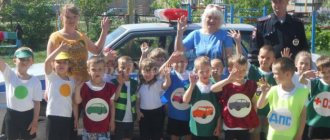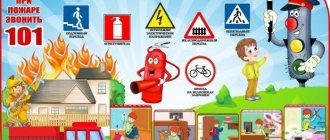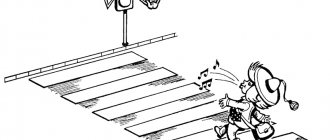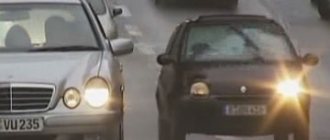Pictures of road signs
Clear drawings of signs with analogies will help you remember the most important symbols that you will encounter on your way to elementary school or kindergarten. Vivid images and simple explanations allow you to instantly attract attention and convey information quickly, cheerfully and clearly.
Thanks to road pictures, the child learns to be independent and make the right decisions. The main goal is to show that participation in traffic is not as scary as it may seem. If you understand the meaning of road signs, you can organize your own actions.
Road pictures are different for each age category. Children learn in the presence of an adult, who prompts actions and explains signs.
Road signs and traffic lights - how to answer a child
How to answer your child what a traffic light and road signs are? It is important for the child and for the parents that the child is always safe , wherever he is - at home, on a walk, on the way to kindergarten, school, etc.
Children love it when important information is presented in the form of a game.
Together with your child, you can draw a picture on the topic “Road Safety” and ask them to color the finished picture. The child will remember important information for him and come up with a story based on it, and will be more vigilant and attentive on the street.
This will interest the child and the child will remember all the most important things.
Figure "Road Safety"
Teaching a child to move properly on the street is a necessity for every parent. When your child understands that he needs to look back when crossing the road, it’s time to start teaching him road signs.
Of course, a child does not necessarily need to understand all the signs. If possible, answer your child's questions if the child shows interest in other traffic signs. Basic traffic signs that will be useful for your child must be learned with him.
Pictures of traffic rules for children
This is a fun activity for different age groups, which at the same time brings great benefits. Every child, just starting to walk, becomes a participant in traffic - goes to kindergarten or school, walks in the yard, learns to ride a bicycle. Studying from strict books is boring and difficult, so as an alternative we offer bright drawings with clear messages.
The learning process attracts the child with its accessibility and diversity. Any adult can help understand the images by adding examples from personal experience to the drawing. As a result, confidence in himself and his actions in any situation is formed, he will not be confused or scared at the sight of a moving car and will know what to do at a pedestrian crossing. Traffic rules drawings are quick answers to children's questions.
Basic road signs that a child should know about
Tell your child that signs are used on roads to make it easier for pedestrians and drivers to navigate. During walks, tell your child about certain signs, ask him to name some of them as he learns them.
Teach your child to get ready for the trip so that he has a normal amount of time left for a walk. Then he won’t have to run somewhere, he will be able to focus on what surrounds him and will not forget about the rules of the road.
Start learning with the following signs
Pedestrian crossing sign.
An important sign for a child. This sign marks a place where pedestrians can legally cross the street (where they are likely to yield to cars, even if there is no traffic light). Usually installed in front of intersections, near bus stops, shopping centers and crowded places. There are three types of crossings - above-ground ZEBRA, above-ground and underground. The signs of such transitions are slightly different. In the case of an underground and overground passage, the person depicted on the sign is supplemented with a ladder - up or down.
Sign "Caution, children!"
Sign "Caution, children!" serves as a warning to the driver. It means that a child may run out onto the road, and the driver should slow down. Typically, such a sign is installed near schools and playgrounds. But children must know firmly: even under this sign you cannot cross the road if there are no markings and a pedestrian crossing sign.
No Bicycles Sign
This sign applies to cyclists and people on scooters and mopeds. The rule has no exceptions, so in order not to be a violator, you just need to walk and roll your bicycle, moped or scooter to your destination. The same applies to a scooter.
Sign "Pedestrian traffic prohibited"
The traffic rules set by this sign apply only to the part of the road where it is installed. Usually located in places where there are no curbs or sidewalks and the traffic is quite busy.
Road Works Sign
This sign is installed when repairing the roadway, cutting branches on the side of the road, etc. The child needs to be explained that they should not go to the place where repair work is going on, since if you find yourself in that place, you can get hurt, even if you just pass by.
Stop sign
“Stop” is a sign warning that there is a bus, trolleybus, or tram stop here. Only in this place can you get on or off transport . Stopping is prohibited in other places.
Pedestrian zone sign
Pedestrian zone is a section of the road where movement is permitted only on foot. It is important to show not only the beginning of the pedestrian zone (this is where the sign is located), but also its end. After all, where the pedestrian zone ends, the vehicle traffic zone begins.
Road alphabet in pictures
This is play-style learning. Vivid images are better remembered and attract children's attention better than dry texts and abstruse phrases. This alphabet has a dual function - visual teaching of literacy plus familiarization with road traffic and its participants. The child will easily remember the order of letters in the alphabet and their spelling, and will also know the designations of markings, signs, vehicles, etc.
The participation of an adult in the process of learning the alphabet can only be limited to testing the acquired knowledge. Colorful pictures and simple explanations are learned by children of different ages. As a result, the child is well oriented in traffic situations, learns in which places to cross the road, and will be able to distinguish between traffic lights and road sign designations.
Non-existent road signs
This is a great conceptual way to develop a child's understanding of the world. Based on simple drawings, the child develops logical thinking, associative perception, and adapts to social life. Road traffic is an integral part of modernity, vehicles and pedestrians intersect everywhere. Understanding the basics of traffic rules means being safe.
Pictures with non-existent road signs are beneficial because they develop in the child an idea of real symbols that need to be followed. At the same time, fantasy develops thanks to imaginary objects. Children easily reproduce or invent new colorful images. This learning process is built in a game format and is preparatory to further study of the signs from the Rules.
Road signs for children - a play option
As you probably guess, the first teaching aids for your baby will be toys, for example, small road signs for children, which can be bought at the nearest Detsky Mir store. They often come in the same set with cars or railroads. Before the child starts playing, show him each sign, tell him what it means, what it represents. Of course, for children’s perception it is necessary to use only those signs that they can understand (after all, not everything is still accessible to them due to their age!).
The most important road signs for children are signs from two groups: warning and prohibitory. The simplest and most understandable among them: two running men, a pedestrian crossing. Tell your child what this means, and then play together: let your favorite squirrel or bunny go for a walk, go out onto the road (where there will be small trucks and cars) and find the signs there. The child will explain to the bunny that where the road crossing is drawn, cars must stop, and the squirrel must cross the road. And seeing two running men in a triangle with a red border, the truck should drive very slowly and, if necessary, stop immediately: children may run out in front.
When the baby has mastered two or three warning signs, you can move on to prohibitive signs: these are those depicted in a circle with a red border. There are many of them, however, there is no point in forcing a child to memorize them all at once. Among such signs, the following are important: an image of a bicycle (bicycles are prohibited), a crossed out man (pedestrians are not allowed to walk). Remember: the main goal of your game (your educational lesson): the child must learn and understand the meaning of the most important signs for his life.
Be sure to tell him about the traffic light. Buy him a toy traffic light, let it shine either red, then yellow, or green, letting the toy men pass. Boys usually like this game more, because cars and everything connected with them often begin to interest them from early childhood. But even for a girl, the game can become entertaining if Vasilisa’s favorite doll, heading to kindergarten, acts as a pedestrian, and the car that has stopped to let her cross the road is pink, with a flirty bow on the bumper.



